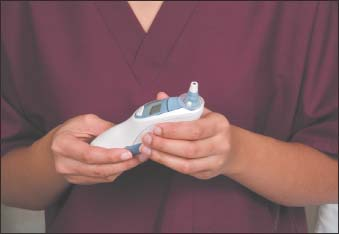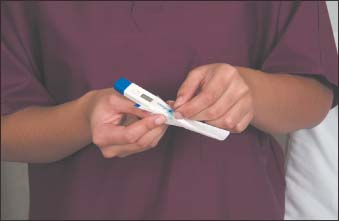Temperature Assessment
Body temperature represents the balance between heat produced by metabolism, muscular activity, and other factors and heat lost through the skin, lungs, and body wastes. A stable temperature pattern promotes proper function of cells, tissues, and organs; a change in this pattern usually signals the onset of illness.
Temperature can be measured with an electronic digital, chemical-dot, or tympanic thermometer. Oral temperature in adults normally ranges from 97° to 99.5°F (36.1° to 37.5°C); rectal temperature, the most accurate reading, is usually 1°F (0.6°C) higher; axillary temperature, the least accurate, reads 1° to 2°F (0.6° to 1.1°C) lower; and tympanic temperature reads 0.5° to 1° (0.3° to 0.6°) higher.1
Temperature normally fluctuates with rest and activity. Lowest readings typically occur between 4 and 5 a.m.; the highest readings occur between 4 and 8 p.m. Other factors also influence temperature, including gender, age, emotional conditions, and environment. Keep the following principles in mind: Women normally have higher temperatures than men, especially during ovulation. Normal temperature is highest in neonates and lowest in the elderly. Heightened emotions raise temperature; depressed emotions lower it. A hot external environment can raise temperature; a cold environment lowers it.
Equipment
Electronic thermometer, chemical-dot thermometer, or tympanic thermometer ▪ facial tissue ▪ disposable thermometer sheath or probe cover (except for chemical thermometer) ▪ alcohol pad.
Preparation of Equipment
If you use an electronic thermometer, make sure it’s been recharged. (See Types of thermometers, page 698.)
Chemical-Dot Thermometer
Remove the thermometer from its protective dispenser case by grasping the handle end with your thumb and forefinger, moving the handle up and down to break the seal, and pulling the handle straight out. Keep the thermometer sealed until use.
Implementation
Confirm the patient’s identity using at least two patient identifiers according to your facility’s policy.5
Explain the procedure to the patient.
If the patient has had hot or cold liquids, chewed gum, or smoked, wait 15 minutes before taking an oral temperature.6
Taking A Tympanic Temperature
Make sure the lens under the probe is clean and shiny. Attach a disposable probe cover (as shown below).

Examine the patient’s ear. It should be free from cerumen to obtain an accurate reading. If the patient has any visible lesions or drainage, don’t perform a tympanic temperature.
Stay updated, free articles. Join our Telegram channel

Full access? Get Clinical Tree


Get Clinical Tree app for offline access

